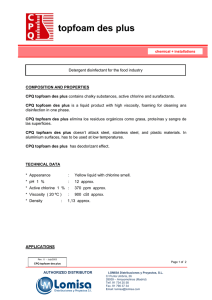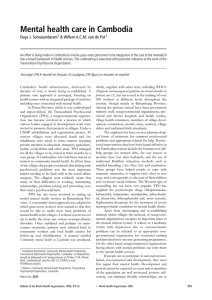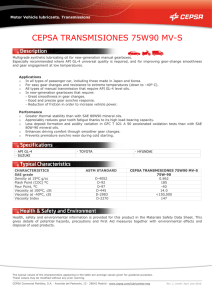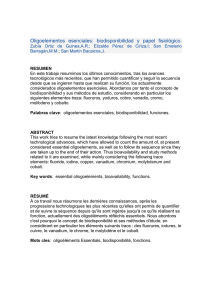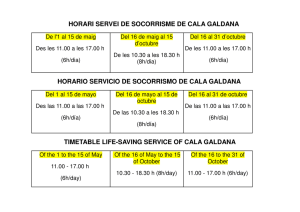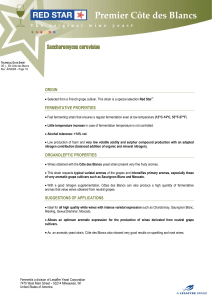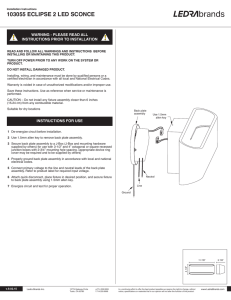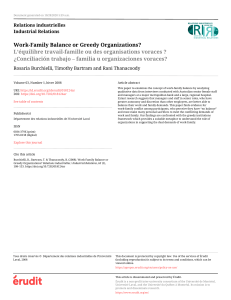LENGTH BASED CATCH CURVE ANALYSIS FOR WHITE MARLIN.
Anuncio
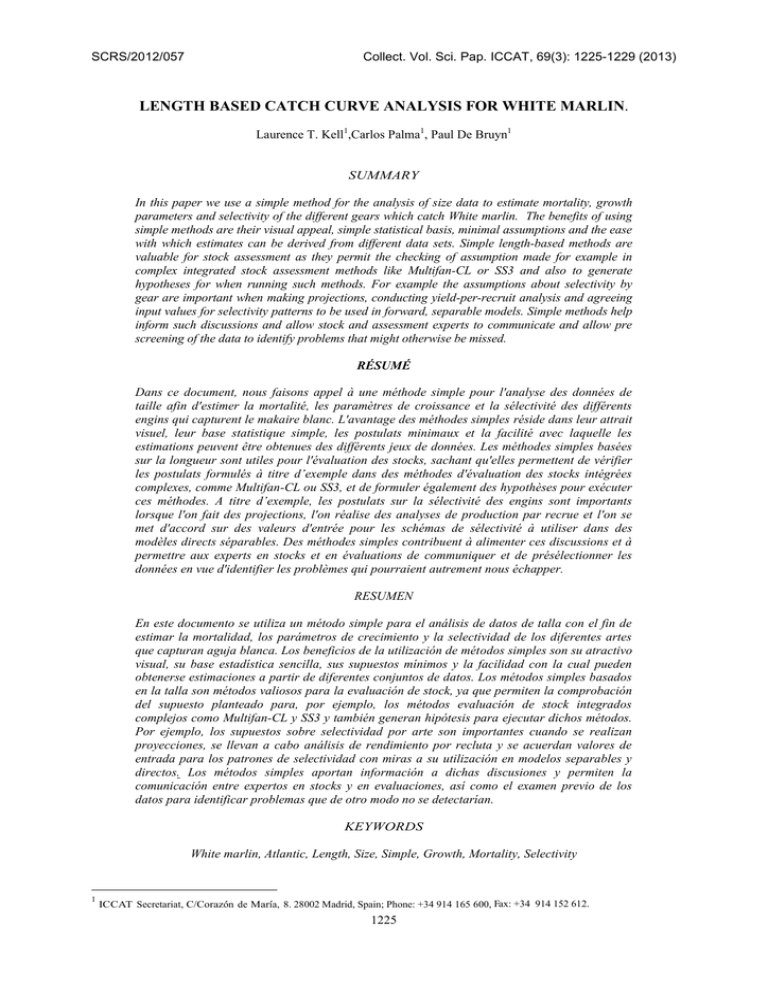
SCRS/2012/057 Collect. Vol. Sci. Pap. ICCAT, 69(3): 1225-1229 (2013) LENGTH BASED CATCH CURVE ANALYSIS FOR WHITE MARLIN. Laurence T. Kell1,Carlos Palma1, Paul De Bruyn1 SUMMARY In this paper we use a simple method for the analysis of size data to estimate mortality, growth parameters and selectivity of the different gears which catch White marlin. The benefits of using simple methods are their visual appeal, simple statistical basis, minimal assumptions and the ease with which estimates can be derived from different data sets. Simple length-based methods are valuable for stock assessment as they permit the checking of assumption made for example in complex integrated stock assessment methods like Multifan-CL or SS3 and also to generate hypotheses for when running such methods. For example the assumptions about selectivity by gear are important when making projections, conducting yield-per-recruit analysis and agreeing input values for selectivity patterns to be used in forward, separable models. Simple methods help inform such discussions and allow stock and assessment experts to communicate and allow pre screening of the data to identify problems that might otherwise be missed. RÉSUMÉ Dans ce document, nous faisons appel à une méthode simple pour l'analyse des données de taille afin d'estimer la mortalité, les paramètres de croissance et la sélectivité des différents engins qui capturent le makaire blanc. L'avantage des méthodes simples réside dans leur attrait visuel, leur base statistique simple, les postulats minimaux et la facilité avec laquelle les estimations peuvent être obtenues des différents jeux de données. Les méthodes simples basées sur la longueur sont utiles pour l'évaluation des stocks, sachant qu'elles permettent de vérifier les postulats formulés à titre d’exemple dans des méthodes d'évaluation des stocks intégrées complexes, comme Multifan-CL ou SS3, et de formuler également des hypothèses pour exécuter ces méthodes. A titre d’exemple, les postulats sur la sélectivité des engins sont importants lorsque l'on fait des projections, l'on réalise des analyses de production par recrue et l'on se met d'accord sur des valeurs d'entrée pour les schémas de sélectivité à utiliser dans des modèles directs séparables. Des méthodes simples contribuent à alimenter ces discussions et à permettre aux experts en stocks et en évaluations de communiquer et de présélectionner les données en vue d'identifier les problèmes qui pourraient autrement nous échapper. RESUMEN En este documento se utiliza un método simple para el análisis de datos de talla con el fin de estimar la mortalidad, los parámetros de crecimiento y la selectividad de los diferentes artes que capturan aguja blanca. Los beneficios de la utilización de métodos simples son su atractivo visual, su base estadística sencilla, sus supuestos mínimos y la facilidad con la cual pueden obtenerse estimaciones a partir de diferentes conjuntos de datos. Los métodos simples basados en la talla son métodos valiosos para la evaluación de stock, ya que permiten la comprobación del supuesto planteado para, por ejemplo, los métodos evaluación de stock integrados complejos como Multifan-CL y SS3 y también generan hipótesis para ejecutar dichos métodos. Por ejemplo, los supuestos sobre selectividad por arte son importantes cuando se realizan proyecciones, se llevan a cabo análisis de rendimiento por recluta y se acuerdan valores de entrada para los patrones de selectividad con miras a su utilización en modelos separables y directos. Los métodos simples aportan información a dichas discusiones y permiten la comunicación entre expertos en stocks y en evaluaciones, así como el examen previo de los datos para identificar problemas que de otro modo no se detectarían. KEYWORDS White marlin, Atlantic, Length, Size, Simple, Growth, Mortality, Selectivity 1 ICCAT Secretariat, C/Corazón de Marı́a, 8. 28002 Madrid, Spain; Phone: +34 914 165 600, Fax: +34 914 152 612. 1225 1. Introduction In this paper we use a simple method for the analysis of size data to estimate mortality, growth parameters and selectivity by gear. Benefits of using simple methods are their visual appeal, simple statistical basis, minimal assumptions and the ease with which estimates can be derived from different data sets. Such simple length-based methods are valuable for stock assessment as they permit the checking of assumption made for example in complex integrated stock assessment methods like Multifan-CL or SS3 and also to generate hypotheses when running the latter methods. For example the assumptions about selectivity by gear are important when making projections, conducting yield-per-recruit analysis and agreeing input values for selectivity patterns to be used in forward, separable models. Simple methods help inform such discussions and allow stock and assessment experts to communicate and allow pre screening of the data to identify problems that might otherwise be missed. 2. Materials and Methods 2.1 Data The data used are length frequencies by fleet/gear in the ICCAT database: these are only samples and are not raised to the total catch. The assumption in the analysis is that these are a random sample from the catch. 2.2 Methods Beverton and Holt [1956] developed a method to estimate population parameters such as total mortality (Z) from length data i.e. ̅ ̅ Based on this equation Powell [1979] developed a method, extended by Wetherall et al. [1987], to estimate growth and mortality parameters. This assumes that the right hand tail of a length frequency distribution is determined by the asymptotic length L and the ratio between Z and the growth rate K. The Beverton and Holt method assumes good estimates for K and L∞ , while the Powell-Wetherall method only requires an estimate of K, since both L∞ and Z/K are estimated. These method therefore provide estimates from each length distribution of Z/K and Z if K is known. As well as assuming that growth follows the von Bertalanffy growth function, it is also assumed that the population is in a steady state with constant exponential mortality, no changes in selection pattern of the fishery and constant recruitment. In the Powell-Wetherall method Lt can take any value between the smallest and largest sizes. Equation1 then provides a series of estimates of Z since ̅ a and b can be estimated by a regression analysis where Therefore plotting when L – Lt is plotted against Lt estimates of L∞ and Z/K are provided. 3. Results Size sample data from the ICCAT database are plotted in Figure 1 these show the length frequency data for all years combined. Some gears are poorly represented in the database these were removed in the analysis. Relative length frequencies are plotted by gear and decade in Figure 2. Data samples are obviously less in the current decade. 1226 The corresponding Powell-Wetherall plots by gear and decade are shown in Figure 3. The slope of the red line K indicates the value of Z and the intercept with the x-axis L∞ . The main feature of the plots is that all the initial points (e.g. from the smaller size classes lie on the line) and that after about 150 cm points fall to the right of the line. Otherwise the plots all look similar. Therefore when fitting the line points with mean lengths greater than 150 cm were excluded. To interpret the plots more fully the estimates of L and Z/K are summarized in Figures 4 and 5 respectively. For L∞ estimates are similar, about 175 cm, for all gears and year (apart from LL in 2010 when the data are poor). For Z/K estimates are similar (except for LLHB, which in this case the data only come from a relatively few size classes.). 4. Discussion Although the Powell-Wetherall method is very simple with few assumptions, it is able to estimate important parameters based on few assumptions, thereby letting the data speak. For example by estimating L∞ it can provide an independent check of the currently assumed values; while if the estimates of L∞ vary from the literature it may suggest a problem in the data. I.e. the method both provides a reality check and screen data prior to running more complicated methods. It is can estimate length at full selectivity, an important parameter in many stock assessment methods. While Z can be estimated if K is known, and F is M is known. The method is also a useful tool prior to running other simple methods such as Survival Estimates In NonEquilibrium situations assessment method (SEINE) Gedamke and Hoenig [2006]. Simple models potentially are also useful in allowing greater communication between stock and fishery experts and assessment modelers. References R. Beverton and S. Holt. review of method for estimating mortality rates in exploited fish populations, with special reference to sources of bias in catch sampling. Rapports et Proces-Verbaux., 140(1):67–83, 1956. T. Gedamke and J. Hoenig. Estimating mortality from mean length data in nonequilibrium situations, with application to the assessment of goosefish. Transactions of the American Fisheries Society, 135 (2):476– 487, 2006. D. G. Powell. Estimation of mortality and growth parameters from the length frequency of a catch [model]. Rapports et Proces-Verbaux des Reunions, 175, 1979. J. Wetherall, J. Polovina, and S. Ralston. Estimating growth and mortality in steady-state fish stocks from length-frequency data. In ICLARM Conf. Proc, pages 53–74, 1987. 1227 Figure 1. Length frequency distribution by gear. Figure 2. Length frequency distribution by main gears and decade. 1228 Figure 3. Summary of L∞ estimates by gear and decade. Figure 4.Summary of Z/K estimates by gear and decade. 1229
